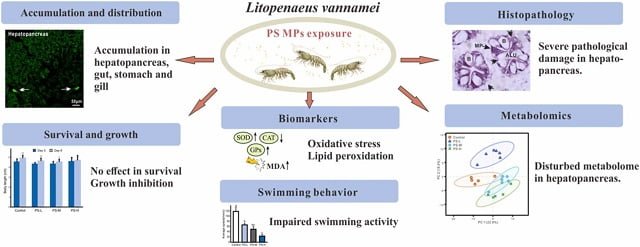
Microplastics represent one of the major environmental threats to marine organisms and ecosystems globally. There is growing evidence demonstrating the ingestion of microplastics by fish, bivalves, crustaceans, and zooplankton.
The ingested microplastics can accumulate in tissues for a long period of time due to their small size and poor biodegradability. The primary routes of microplastic ingestion in aquatic animals include oral ingestion, respiration, and skin adherence.
Researchers from the Hainan Tropical Ocean University, South China Agricultural University, Institute of Marine Research, University of Bergen, and Institute of Deep-Sea Science and Engineering studied the impacts of microplastic accumulation in Litopenaeus vannamei at the behavioral, histological, and biochemical levels.
Distribution and accumulation of microplastics
The researchers used the fluorescence tracer technique to track the distribution and accumulation of microplastics in various organs of L. vannamei.
“The results of the study showed that microplastic particles were clearly observed in the gills, stomach, intestine, and hepatopancreas, and their distribution characteristics in various organs were identified,” they reported.
The researchers also quantified the microplastic contents in different organs using a fluorescence spectrophotometer.
“It can be seen that the accumulation of microplastics in the hepatopancreas was more abundant than in the gills, stomach, and intestine during exposure and elimination periods,” the study highlights.
Effects of microplastics
According to the study, microplastics accumulated in shrimp caused growth inhibition, abnormal swimming behavior, and reduced swimming performance.
“For the toxicity test, no significant differences in survival rate were found among the groups. However, compared with the controls, the growth of L. vannamei was inhibited by 52.1% when exposed to the highest concentration of microplastics,” they describe.
The study also reports that compared to the controls, exposure to microplastics at three concentrations significantly decreased the average swimming speed of L. vannamei, by between 43.7% and 80.2%.
Survival of Shrimps
According to the study, the accumulation of microplastics does not significantly affect the survival of L. vannamei at three concentrations (from 0.02 to 1.0 mg/L) after 8 days of exposure.
Oxidative Stress
The researchers report that after exposure to microplastics, oxidative stress and lipid peroxidation were also observed, which were strongly related to attenuated swimming activity in L. vannamei.
“The disturbance of the antioxidant system balance induced by microplastics triggered hepatopancreatic damage in L. vannamei,” they emphasized.
Additionally, the study describes that metabolomics revealed that exposure to microplastics led to alterations in metabolic profiles and alterations in glycolysis, lipolysis, and amino acid metabolism pathways in the hepatopancreas of L. vannamei.
Histological Alterations in the Hepatopancreas
According to the study, the hepatopancreas of L. vannamei accumulates the highest amount of microplastics among all studied organs, and as a result, histopathological changes were particularly evident in this organ.
Microplastics cause damages such as tubular atrophy, loose arrangement of tubules, loss of lumen structure, and cytolysis of epithelial cells.
The degree of pathological damage was exacerbated with the increase of microplastics concentration.
“This research also revealed that microplastics induce changes in all levels of metabolites linked to lipid metabolism, such as fatty acids and acylcarnitines in the hepatopancreas of L. vannamei,” they reported.
Conclusion
The study characterizes the toxic effects of microplastic accumulation on L. vannamei in aspects such as behavior, tissue histology, enzymatic activity, and metabolome.
“The accumulation and distribution of microplastics were demonstrated in multiple organs, with the hepatopancreas containing the most microplastics. The accumulation of microplastics caused a variety of sublethal effects on L. vannamei, including growth inhibition, changes in swimming behavior, oxidative stress, and hepatopancreatic damage,” they emphasized.
“This study confirms and expands the knowledge about the sublethal impacts and toxic modes of action of microplastics on L. vannamei,” they conclude.
The study was funded by the National Natural Science Foundation of China Hainan Provincial Natural Science Foundation of China, Funding Scheme for High-level Overseas Chinese Students’ Return of Ministry of Human Resources and Social Security of China, Science and Technology Project of Yazhou Bay Innovation Institute of Hainan Tropical Ocean University, Hainan Provincial Joint Project of Sanya Yazhou Bay Science and Technology City and Scientific Research Foundation of Hainan Tropical Ocean University.
Contact
Yingxu Zeng
Hainan Tropical Ocean University
No. 1 Yucai Road, Sanya 572000, China.
Email: zengyx@hntou.edu.cn
Reference (open access)
Yingxu Zeng, Baichuan Deng, Zixin Kang, Pedro Araujo, Svein Are Mjøs, Ruina Liu, Jianhui Lin, Tao Yang, Yuangao Qu. Tissue accumulation of polystyrene microplastics causes oxidative stress, hepatopancreatic injury and metabolome alterations in Litopenaeus vannamei. Ecotoxicology and Environmental Safety, Volume 256, 2023, 114871, ISSN 0147-6513, https://doi.org/10.1016/j.ecoenv.2023.114871.
Editor at the digital magazine AquaHoy. He holds a degree in Aquaculture Biology from the National University of Santa (UNS) and a Master’s degree in Science and Innovation Management from the Polytechnic University of Valencia, with postgraduate diplomas in Business Innovation and Innovation Management. He possesses extensive experience in the aquaculture and fisheries sector, having led the Fisheries Innovation Unit of the National Program for Innovation in Fisheries and Aquaculture (PNIPA). He has served as a senior consultant in technology watch, an innovation project formulator and advisor, and a lecturer at UNS. He is a member of the Peruvian College of Biologists and was recognized by the World Aquaculture Society (WAS) in 2016 for his contribution to aquaculture.
